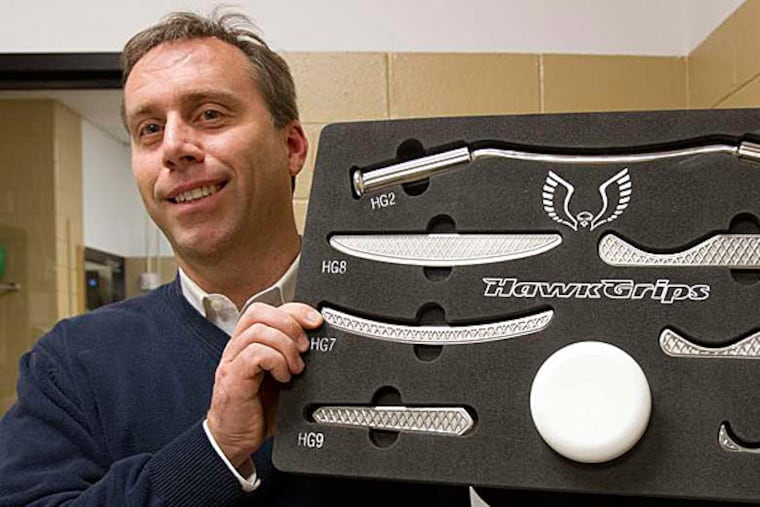Providing the tools to help others heal
Not that he's an Olympic-caliber skier, but when Frank Osborne heard that downhill phenom Lindsey Vonn had crashed on a training run last month in Vail, Colo., he could relate.

Not that he's an Olympic-caliber skier, but when Frank Osborne heard that downhill phenom Lindsey Vonn had crashed on a training run last month in Vail, Colo., he could relate.
On Jan. 14, 1997, the Cheltenham native was 22, a recent graduate of St. Joseph's University, living in the Poconos, and tempting fate: the double black diamond run he had wiped out on the first time he tried it that day.
So Osborne went down it again, at night, and, as he recalls, was out of control pretty much from the start: "I was just flying."
Until he veered off the side of Camelback Mountain. "I don't remember hitting the tree," he said recently.
His injuries left no doubt: broken neck and back; fractures of the left arm and wrist; and tears to both shoulders and right biceps, to name a few.
Osborne underwent 30 surgeries. Physical therapy lasted 11 years. And from that came the entrepreneurial inspiration to take on a leader in the soft-tissue rehabilitation industry whose tools had provided him with the only meaningful relief in his agonizing search for it.
"I went from loving them to 'I'm going to take these people down,' " said Osborne, who in 2012 founded HawkGrips. (The name is a nod to the mascot of his alma mater.)
Based in Conshohocken, HawkGrips makes stainless-steel tools to address soft-tissue irregularities. They are used in instrument-assisted soft-tissue mobilization (IASTM), a healing process involving controlled microtrauma - the rubbing of an instrument over an area, aided by emollients to reduce friction - to break up scar tissue and promote blood flow.
Osborne's own recovery regimen - including acupuncture, massage, yoga, even bee stings - brought little relief, he said. Then in March 2008, he saw a TV news report on the Graston Technique. He sought out a therapist trained in the use of Graston tools and, for the first time since the accident, was able to swivel his head enough to see over his shoulders.
He asked if he could buy the tools and was told by the therapist and Graston, an Indianapolis company, that sales were limited to clinicians of a certain standard who went through Graston's certification course.
"I hung up a little bit deflated," Osborne said.
So the pharmaceutical-marketing graduate hired lawyers and engineers and set out to produce the same tools - with improvements.
"I basically copied the good parts," he said.
From Graston users, he said, he had heard complaints about tools slipping out of their hands - and about the required prepurchase certification.
HawkGrips, manufactured in Pennsylvania and New Jersey, include cross-hatchings on the handles to prevent slippage. Course work is not required before purchase.
Todd R. Lugar, president and CEO of 20-year-old Graston Technique L.L.C., is not conceding anything to HawkGrips, and he expressed frustration over the emergence of a dozen-plus copycats since the recent expirations of Graston's five patents.
"We've got everyone out there running to their local machine shop replicating our instruments," Lugar said. "What they can't replicate is the education behind it."
Lugar is big on Graston's training: a 12-hour course, starting at $550 a person.
"We're going to compete for the same market, that's fine," he said of Osborne. "The problem is when you introduce an element of risk to a patient. You're going to do that as long as you peddle an instrument that does not require training."
Osborne took offense.
"We provide training, and we also work with companies and universities across the United States that offer accredited IASTM training," he said in an e-mail last week while on a business trip. "Unlike our competitor, we don't treat training as a source of revenue."
Osborne cited a lengthy list of college and professional sports teams using HawkGrips - including the Flyers, Eagles, 76ers, and Phillies - as proof that his tools "are both effective and safe."
Also on that list is physical-therapy heavyweight NovaCare Rehabilitation, with 90 locations in Southeastern Pennsylvania and South Jersey and 1,000 throughout the United States.
Said NovaCare president Dan Bradley: "HawkGrips tools have been a good addition for use by our therapists, providing positive outcomes to our patients."
Graston has 17,000 trained therapists, with 445 in Pennsylvania and 411 in New Jersey, including at NovaCare, Lugar said. He would not disclose annual sales.
Nor would Osborne. HawkGrips range from a few hundred dollars per instrument to a few thousand for a set.
Osborne has not yet recouped his $1 million in start-up costs. Or skied since the disaster that started it all.
But his tools soon will get heady slope exposure - joining the U.S. ski team in Sochi, Russia, in February for the Winter Olympics.
"They'll be an integral part of our therapy sessions," said Greg Heuer, freestyle head athletic trainer.
>Inquirer.com
Frank Osborne introduces his physical- therapy tools, HawkGrips, which are used on soft-tissue irregularities. www.inquirer.com/small_businessEndText